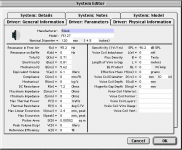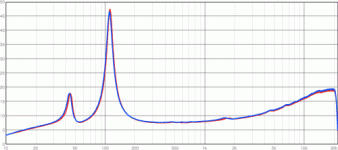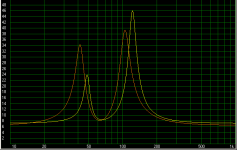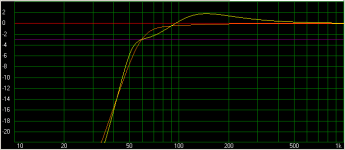This discussion has stemmed off from http://www.diyaudio.com/forums/showthread.php?s=&threadid=123383
Attached is the measured T/S Parameters for the FE127E as measured by Planet10. These are the average of 120(!) drivers.
My measurements of the Fostex FE127E driver (n=4) are fairly close.
In both cases, the measurements are quite different from what Fostex has published.
Attached is the measured T/S Parameters for the FE127E as measured by Planet10. These are the average of 120(!) drivers.
My measurements of the Fostex FE127E driver (n=4) are fairly close.
In both cases, the measurements are quite different from what Fostex has published.
Attachments
This is the impedance sim of the Fonken.
The orange line is the simulation using the Fostex T/S numbers.
The yellow line is the simulation using the measured T/S numbers.
As you can see, the measured T/S are much closer to the impedance curve in post #2. The small differences are likely the result of the damping material. The simulation does not account for damping.
The orange line is the simulation using the Fostex T/S numbers.
The yellow line is the simulation using the measured T/S numbers.
As you can see, the measured T/S are much closer to the impedance curve in post #2. The small differences are likely the result of the damping material. The simulation does not account for damping.
Attachments
Here is the simulated frequency response. Note that the simulation does not take into account the room.
Again, orange is using the Fostex parameters and yellow are the measured parameters.
Despite the fact that the T/S parameters are very different, you can see that the response is within about 2 dB. A change of 3 dB is generally considered the threshold of hearing and 2 dB is a far cry from what a room will do to the sub 150 Hz response.
edit=typo
Again, orange is using the Fostex parameters and yellow are the measured parameters.
Despite the fact that the T/S parameters are very different, you can see that the response is within about 2 dB. A change of 3 dB is generally considered the threshold of hearing and 2 dB is a far cry from what a room will do to the sub 150 Hz response.
edit=typo
Attachments
gmilitano said:
In both cases, the measurements are quite different from what Fostex has published.
Depends on your viewpoint. If their calc'd efficiencies are reasonably close, then a cab designed around its published specs should perform well regardless of the disparity between Fs, Vas, Qes. I calc 89.98 dB/W/m published Vs Dave's 90.18 dB/W/m and 90.72 dB/W/m for your one with a Vas spec, an insignificant ~0.22% and 0.82% error respectively, either of which any speaker manufacturer's QA dept. would be proud of.
Note that this line of reasoning doesn't apply to drivers for use in compression horns where the motor's strength (Qes) is key to good performance and of course if you have measured specs might as well use them.
GM
Re: Re: Fostex T/S Paraemeters - Comparison with Fonken
GM,
Could you post some background information on what you have done above. Is that the same as comparing at the ratio of Fs/Qts?
GM said:Depends on your viewpoint. If their calc'd efficiencies are reasonably close, then a cab designed around its published specs should perform well regardless of the disparity between Fs, Vas, Qes. I calc 89.98 dB/W/m published Vs Dave's 90.18 dB/W/m and 90.72 dB/W/m for your one with a Vas spec, an insignificant ~0.22% and 0.82% error respectively, either of which any speaker manufacturer's QA dept. would be proud of.
GM,
Could you post some background information on what you have done above. Is that the same as comparing at the ratio of Fs/Qts?
Load these formulas into Excel/whatever to calc a reference efficiency for comparing drivers:
n0 = (K*Fs^3*Vas)/Qes
where:
n0 = reference efficiency in percent
K = 9.6352e-10 (Vas in liters)
K = 9.6352e-7 (Vas in cc)
K = 2.723e-8 (Vas in ft^3)
then:
sens = 112.018+10*(log10(n0))
No.
GM
n0 = (K*Fs^3*Vas)/Qes
where:
n0 = reference efficiency in percent
K = 9.6352e-10 (Vas in liters)
K = 9.6352e-7 (Vas in cc)
K = 2.723e-8 (Vas in ft^3)
then:
sens = 112.018+10*(log10(n0))
No.
GM
Re: Re: Fostex T/S Paraemeters - Comparison with Fonken
Given that drivers with a wide range of TS parameters would all perform 'well' in the same cabinet, provided that their calculated efficiencies were close, is there any advantage in using the actual TS parameters. Put another way, if a person were to design resonant, non-horn enclosures for the FE127E, one optimized for the Fostex TS numbers and the other for the actual TS numbers, would the enclosure designe using the actual numbers perform better?
Regards,
Bob
GM said:
Depends on your viewpoint. If their calc'd efficiencies are reasonably close, then a cab designed around its published specs should perform well regardless of the disparity between Fs, Vas, Qes. I calc 89.98 dB/W/m published Vs Dave's 90.18 dB/W/m and 90.72 dB/W/m for your one with a Vas spec, an insignificant ~0.22% and 0.82% error respectively, either of which any speaker manufacturer's QA dept. would be proud of.
Note that this line of reasoning doesn't apply to drivers for use in compression horns where the motor's strength (Qes) is key to good performance and of course if you have measured specs might as well use them.
GM
Given that drivers with a wide range of TS parameters would all perform 'well' in the same cabinet, provided that their calculated efficiencies were close, is there any advantage in using the actual TS parameters. Put another way, if a person were to design resonant, non-horn enclosures for the FE127E, one optimized for the Fostex TS numbers and the other for the actual TS numbers, would the enclosure designe using the actual numbers perform better?
Regards,
Bob
Depends on what you're either expecting or need for the app I guess. I mean the majority of cabs I've designed/built were either done with no specs beyond the manufacturer's listed Fs and some general compliance references (Vas) combined with its effective piston area (Sd) to later adding its calc'd Qo (similar to Qts) to the 'mix' and finally in more recent times comparing their perceived performance against measured T/S specs where available and almost always the sims didn't look all that good nor matched up all that well with what me and others heard. Not surprising considering how much the room dominates down low.
Then consider all the designs me and others have posted using published specs that folks built/claimed performed extremely well, though which one they would choose (if either) in a blind A/B comparison remains to be seen.
WRT good 'sounding' though, I question the need to ever use measured specs for 'FR' sealed or vented alignments unless the manufacturer is known to publish 'fantasy' specs as a matter of business policy. IMO, measured specs plus any VC heating and/or suspension non-linearity considerations are for where the app demands some very specific performance goals such as the max gain BW for the least bulk, its measured response closely mirrors the sim for XO design, etc..
GM
Then consider all the designs me and others have posted using published specs that folks built/claimed performed extremely well, though which one they would choose (if either) in a blind A/B comparison remains to be seen.
WRT good 'sounding' though, I question the need to ever use measured specs for 'FR' sealed or vented alignments unless the manufacturer is known to publish 'fantasy' specs as a matter of business policy. IMO, measured specs plus any VC heating and/or suspension non-linearity considerations are for where the app demands some very specific performance goals such as the max gain BW for the least bulk, its measured response closely mirrors the sim for XO design, etc..
GM
And it seems that is the approach that several take with FR units. You will often see all sorts of drivers dropped into the same enclosure and subjectively a lot of us (myself included) report that they sound good. The BD-Pipes are a very good example of this.
Look at the plots above, only a 2 dB difference .. hardly audible. In my room I see 10dB swings at ~60Hz and ~120Hz.
Look at the plots above, only a 2 dB difference .. hardly audible. In my room I see 10dB swings at ~60Hz and ~120Hz.
GM said:Depends on what you're either expecting or need for the app I guess. I mean the majority of cabs I've designed/built were either done with no specs beyond the manufacturer's listed Fs and some general compliance references (Vas) combined with its effective piston area (Sd) to later adding its calc'd Qo (similar to Qts) to the 'mix' and finally in more recent times comparing their perceived performance against measured T/S specs where available and almost always the sims didn't look all that good nor matched up all that well with what me and others heard. Not surprising considering how much the room dominates down low.
GM
That sounds similar to the methodology I started with in the 70's. It was described in 'Fundamentals of Loudspeaker Design' by Lampton and Chase, published in Audio, December 1973. I got into the habit of measuring parameters because, for the most part, they were not published.
gmilitano said:And it seems that is the approach that several take with FR units. You will often see all sorts of drivers dropped into the same enclosure and subjectively a lot of us (myself included) report that they sound good. The BD-Pipes are a very good example of this.
Look at the plots above, only a 2 dB difference .. hardly audible. In my room I see 10dB swings at ~60Hz and ~120Hz.
I too have taken that approach. I have test boxes with adapter plates. I run sims for a driver, then try them out in the test box best suited and have a listen. I usually get more than passable results in these boxes. And yes, similar drivers do well in similar boxes. However, by tweaking the design, often by what sims as only a few db change, I can get the character of the bass to change from strong with good extension, to well extended, fast and with real musical character.
With respect to using actual/measured TS parameters vs published ones, my preference to to use the most accurate data for input to sim tools, allowing them to provide the clearest possible picture of the loudspeakers performance. Then I listen, sim again, adjust and listen.
Bob
As a minimum, I always check Re and Fs because these China build houses are pretty bad with Q/C. You can do it with a DMM and a computer or test cd.
http://sound.westhost.com/tsp.htm
http://sound.westhost.com/tsp.htm
- Status
- This old topic is closed. If you want to reopen this topic, contact a moderator using the "Report Post" button.
- Home
- Loudspeakers
- Full Range
- Fostex T/S Paraemeters - Comparison with Fonken



